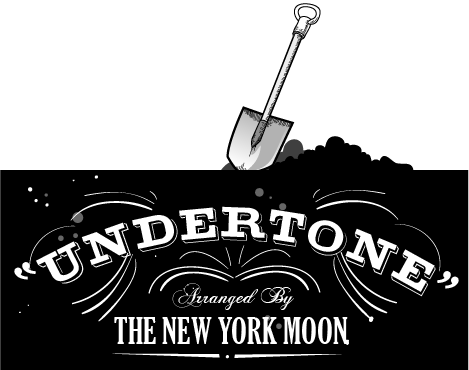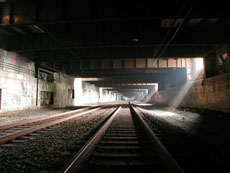

Views of the
Atlantic Avenue Tunnel
 |
 |
 |
 |
 |
 |
 |
 |
 |
 |
 |
 |
All photographs by Konrad Fiedler

“Undertone”

“6th Avenue Local” by Aurora Andrews
All illustrations by Aurora Andrews
There is only one entrance to the Atlantic Avenue tunnel: a manhole in between two lanes of traffic in downtown Brooklyn.
As the tunnel’s guests descend a rickety ladder into its warm, damp penetralia, there is a feeling of crossing a boundary. It is a stark quiet; everything is covered with a wet rust and the dirt floor is rippled as if some subterranean wind once blew through the archway. It is just one of hundreds of spaces formed as the city builds upon itself, sealing off the unnecessary spaces as it grows.






These hidden spaces have the power to evoke emotions of adventure and danger that few places can in a city where everyday life is increasingly virtual.
Underground explorers across the city live for this kind of crossing. The authors of “Invisible Frontier: Exploring the Tunnels, Ruins, and Rooftops of Hidden New York” describe the allure particularly well in the book’s opening:
“IN THE SHADOWS of the city awaits an invisible frontier — a wilderness, thriving in deep places, woven through dead storm drains, and live subway tunnels, coursing over third rails. The frontier waits in the walls of abandoned tenements, it hides on the rooftops, and it infiltrates the bridges’ steel. It’s a no-man’s-land, fenced off with razor wire, marked by warning signs, persisting in shadow, hidden everywhere as a parallel dimension. Crowds hurry through the bright streets, insulated by the pavement, never reflecting that beneath their feet lurks a universe.”
These hidden spaces have the power to evoke emotions of adventure and danger that few places can in a city where everyday life is increasingly virtual. And in a time of terrorist alerts and “sleeper cells,” the bare infrastructure of the city seems even more off limits. But this, it turns out, has always been the case.
After the Atlantic Avenue Tunnel was sealed up in 1861, New York City authorities would begin a search for it about once a generation. During World War I they sought German spies allegedly preparing mustard gas in the tunnel and a few decades later they were looking for a gang of counterfeiters and their looted gold. It was believed that the tunnel was the home of “rats the size of cats,” according to old New York Times articles. The lesson seemed to be that evil things are attracted to dark, abandoned places. Each time, however, they broke a hole in the tunnel and found only ancient air.
But others had a different conception of the value of these derelict, subterranean chambers. Walt Whitman, describing the Atlantic Avenue Tunnel as “a passage of Acheron-like solemnity and darkness,” said society could perhaps gain by descending and then rising again from its depths.
“The tunnel,” he wrote, “dark as the grave, cold, damp, and silent. How beautiful look earth and heaven again, as we emerge from the gloom! It might not be unprofitable, now and then, to send us mortals — the dissatisfied ones, at least, and that’s a large proportion — into some tunnel of several days journey. We’d perhaps grumble less, afterward, at God’s handiwork.”

Please write us at newyorkmoon@gmail.com







